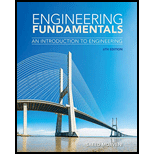
Create a Table of relative resistance of the metals given in the Table 12.1 in the textbook.
Answer to Problem 10P
The table has been created as below.
| Metal | Resistance | Relative Resistance to Copper |
| Aluminum | 17.01 | 1.64 |
| Brass | 66.8 | 6.44 |
| Copper | 10.37 | 1 |
| Gold | 14.7 | 1.42 |
| Iron | 59.9 | 5.78 |
| Lead | 132 | 12.73 |
| Nickel | 50.8 | 4.9 |
| Platinum | 63.8 | 6.15 |
| Silver | 9.8 | 0.95 |
| Tin | 70 | 6.75 |
| Tungsten | 33.2 | 3.2 |
| Zinc | 35.58 | 3.43 |
Explanation of Solution
Given data:
Refer to Table 12.1 in the textbook, which shows the Electrical Resistance for 1 ft long Wire, made of Various Metals Having a Diameter of 1 mil at
The relative resistance of the wire of “1 ft long and 1 mil diameter of aluminum wire” to “1 ft long and 1 mil diameter of aluminum” is calculated as,
Formula used:
Formula to calculate the relative resistance of the material is given by,
Heer,
Resistance of the copper
Calculation:
Refer to Table 12.1 in the textbook, it shows the relative resistance of 1 ft long wires with 1 mil diameter size..
Substitute 17.01 for
Therefore, the relative resistance of the aluminum is
Substitute 66.8 for
Therefore, the relative resistance of the brass is
Substitute 10.37 for
Therefore, the relative resistance of the copper metal is 1.00.
Substitute 14.7 for
Therefore, the relative resistance of the gold is 1.42.
Substitute 59.9 for
Therefore, the relative resistance of the iron is 5.78.
Substitute 132 for
Therefore, the relative resistance of the lead is 12.73.
Substitute 50.8 for
Therefore, the relative resistance of the nickel is 4.90.
Substitute 63.8 for
Therefore, the relative resistance of the platinum is 6.15.
Substitute 9.8 for
Therefore, the relative resistance of the silver is 0.95.
Substitute 70 for
Substitute 33.2 for
Therefore, the relative resistance of the tungsten is 3.20.
Substitute 35.58 for
Therefore, the relative resistance of the Zinc is 3.43.
Conclusion:
Hence the Table for relative resistance of the metals is has been created.
Want to see more full solutions like this?
Chapter 12 Solutions
Engineering Fundamentals: An Introduction to Engineering
- What are the total earned work hours at completion for the column forms?arrow_forward6000 units have been installed to date with 9,000 units to install. Labor costs are $23,300.00 to date. What is the unit cost for labor to date?arrow_forwardThe base rate for labor is $15/hr. The labor burden is 35% and 3% for small tools for the labor. There are 1000 units to install. Records indicate that trade workers can install 10 units per hour, per trade worker. The owners need 15% overhead and profit to pay bills, pay interest on loan and provide some profit to the partners. What is the minimum bid assuming no risk avoidance factor?arrow_forward
- 5. (20 Points) Consider a channel width change in the same 7-foot wide rectangular in Problem 4. The horizontal channel narrows as depicted below. The flow rate is 90 cfs, and the energy loss (headloss) through the transition is 0.05 feet. The water depth at the entrance to the transition is initially 4'. 1 b₁ TOTAL ENERGY LINE V² 129 У1 I b₂ TOP VIEW 2 PROFILE VIEW h₁ = 0.05 EGL Y₂ = ? a) b) c) 2 Determine the width, b₂ that will cause a choke at location 2. Determine the water depth at the downstream end of the channel transition (y₂) section if b₂ = 5 feet. Calculate the change in water level after the transition. Plot the specific energy diagram showing all key points. Provide printout in homework. d) What will occur if b₂ = = 1.5 ft.?arrow_forward4. (20 Points) A transition section has been proposed to raise the bed level a height Dz in a 7-foot wide rectangular channel. The design flow rate in the channel is 90 cfs, and the energy loss (headloss) through the transition is 0.05 feet. The water depth at the entrance to the transition section is initially 4 feet. b₁ = b = b2 1 TOTAL ENERGY LINE V² 129 Ут TOP VIEW 2 hloss = 0.05 " EGL Y₂ = ? PROFILE VIEW a) Determine the minimum bed level rise, Dz, which will choke the flow. b) If the step height, Dz = 1 ft, determine the water depth (y2) at the downstream end of the channel transition section. Calculate the amount the water level drops or rises over the step. c) Plot the specific energy diagram showing all key points. Provide printout in Bework. d) What will occur if Dz = 3.0 ft.?. Crest Front Viewarrow_forward1. (20 Points) Determine the critical depth in the trapezoidal drainage ditch shown below. The slope of the ditch is 0.0016, the side slopes are 1V:2.5H, the bottom width is b = 14', and the design discharge is 500 cfs. At this discharge the depth is y = 4.25'. Also, determine the flow regime and calculate the Froude number. Ye= ? Z barrow_forward
 Engineering Fundamentals: An Introduction to Engi...Civil EngineeringISBN:9781305084766Author:Saeed MoaveniPublisher:Cengage Learning
Engineering Fundamentals: An Introduction to Engi...Civil EngineeringISBN:9781305084766Author:Saeed MoaveniPublisher:Cengage Learning Residential Construction Academy: House Wiring (M...Civil EngineeringISBN:9781285852225Author:Gregory W FletcherPublisher:Cengage Learning
Residential Construction Academy: House Wiring (M...Civil EngineeringISBN:9781285852225Author:Gregory W FletcherPublisher:Cengage Learning


